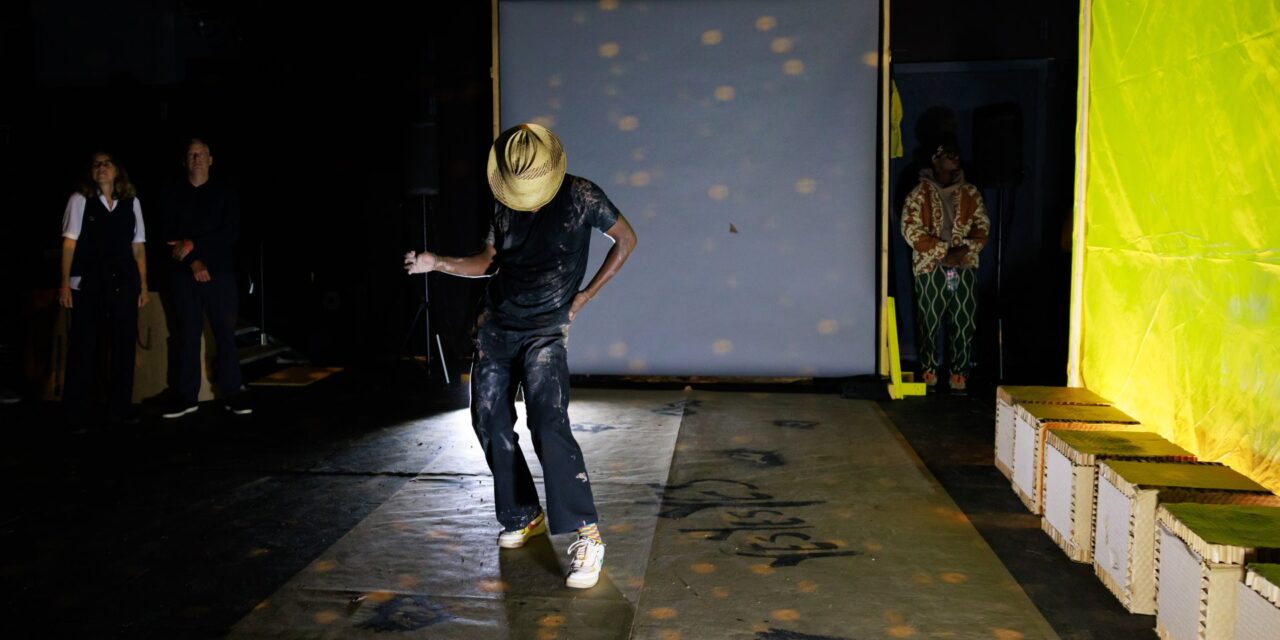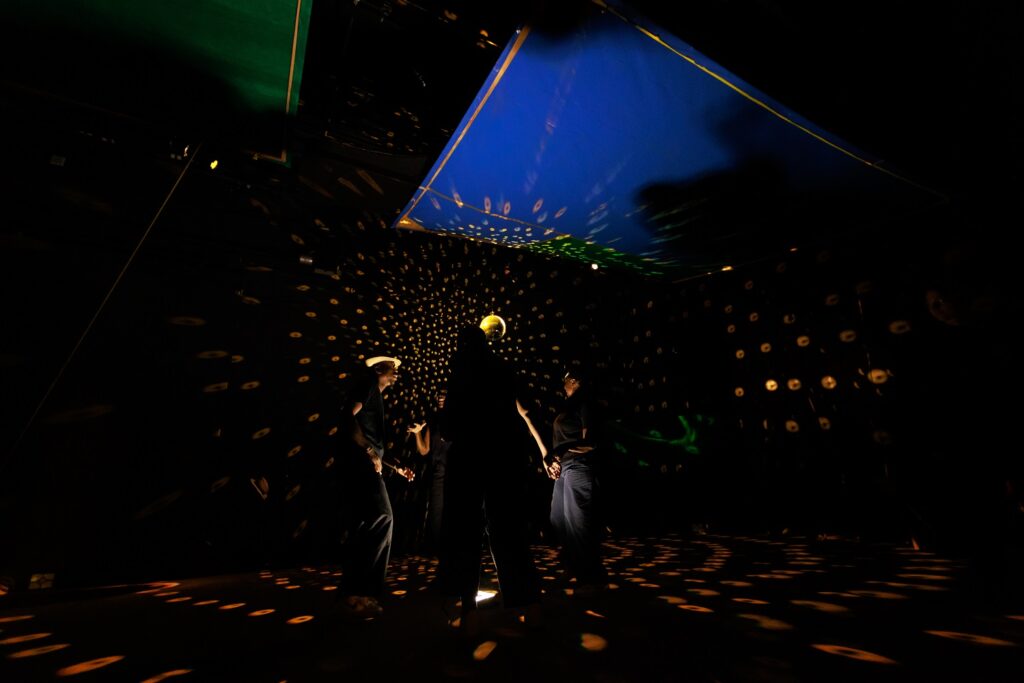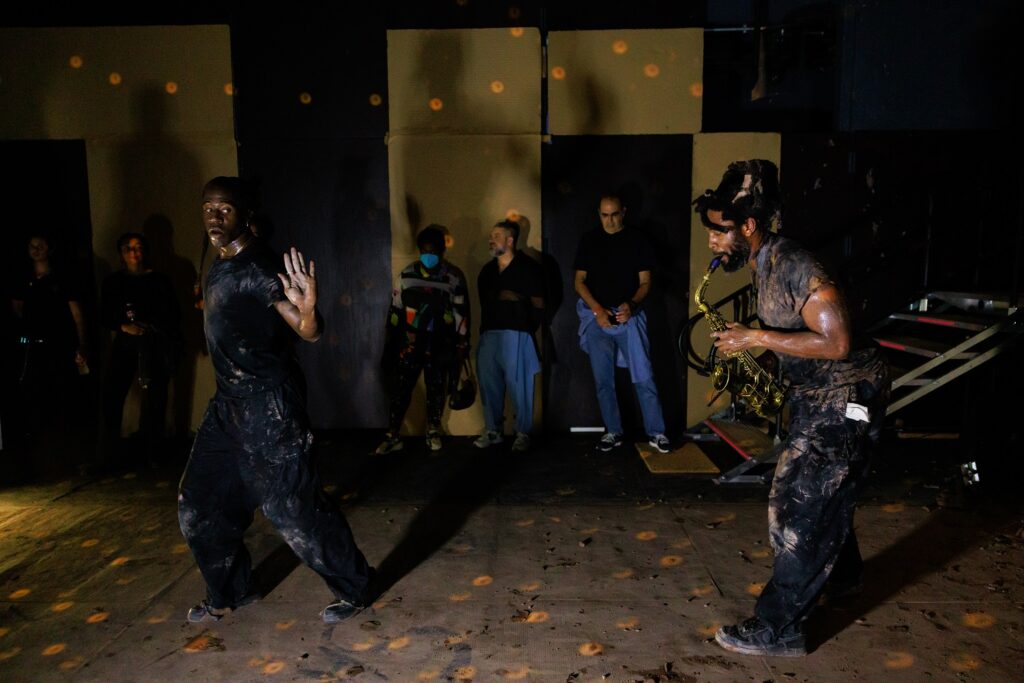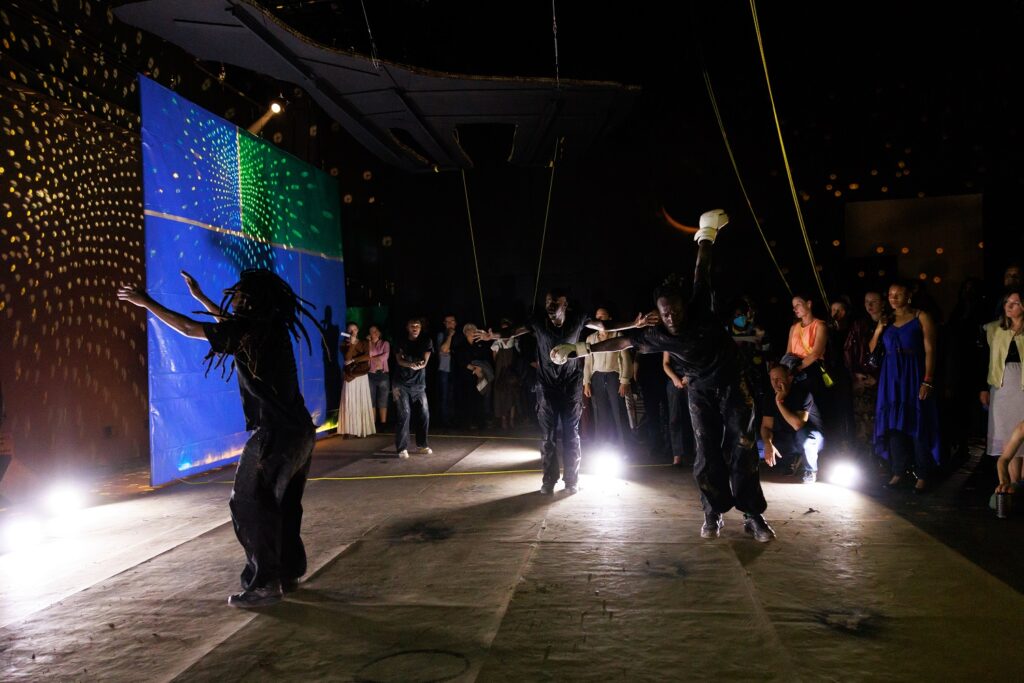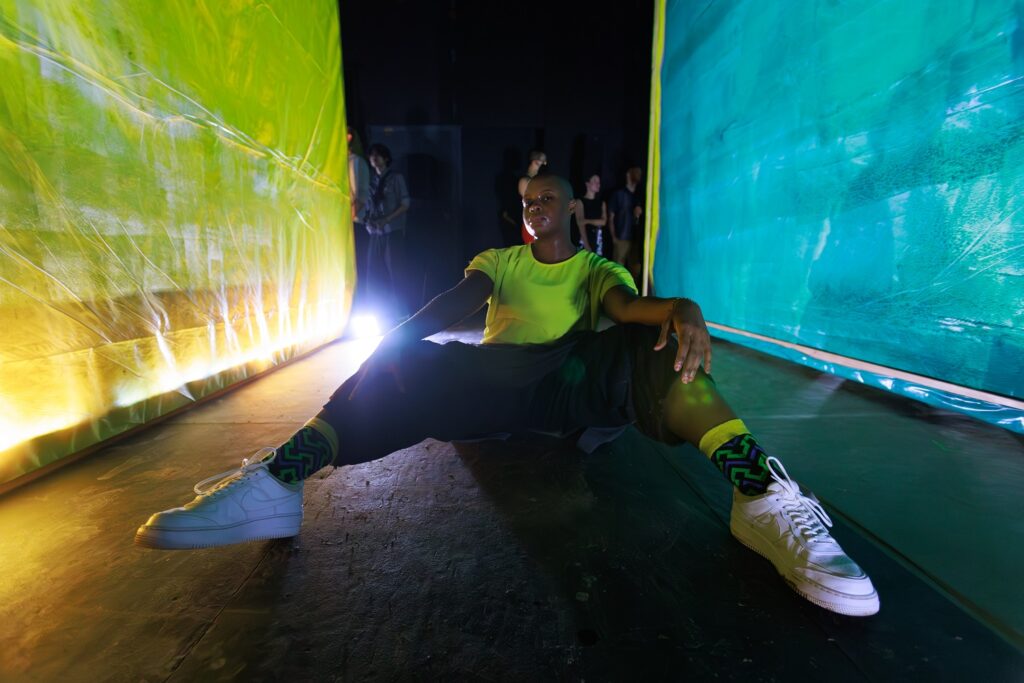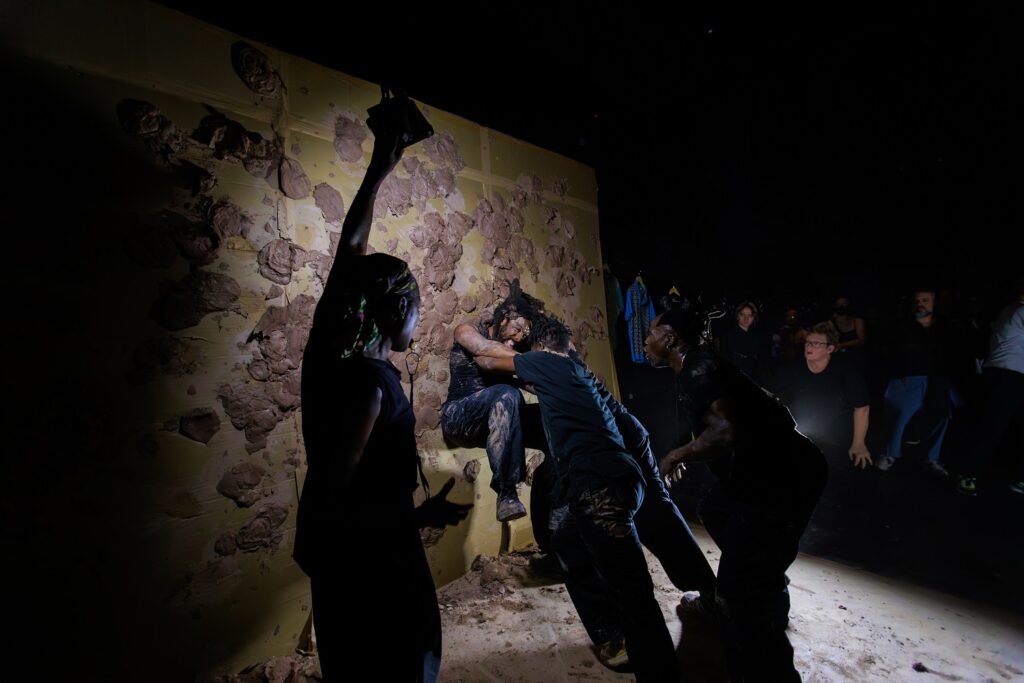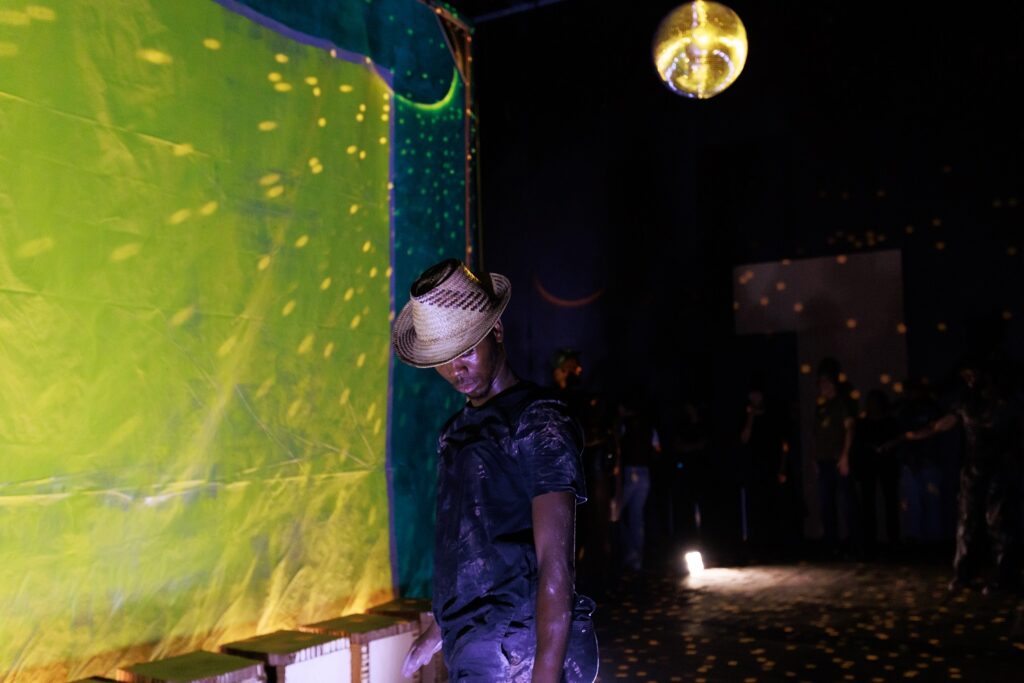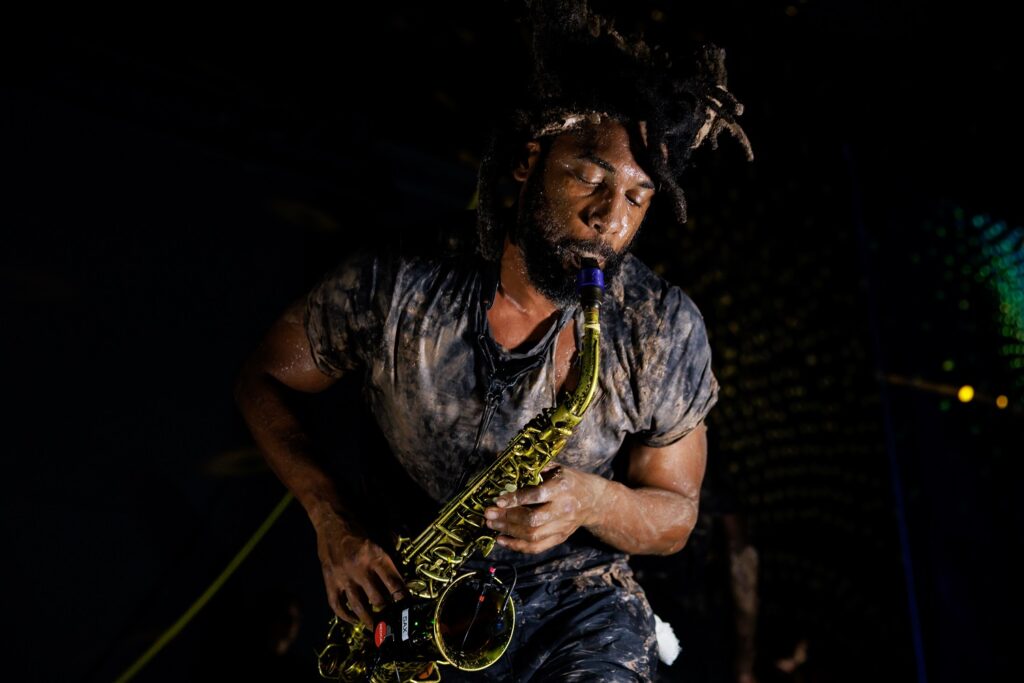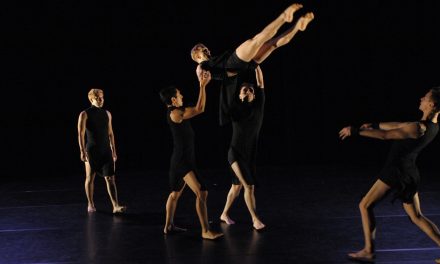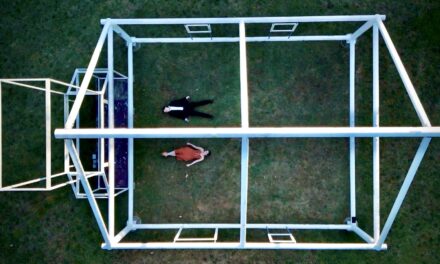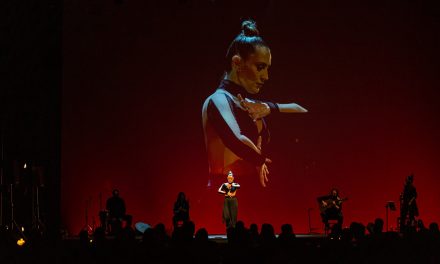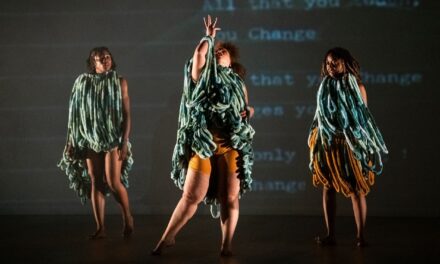A performer danced, swaying their hips to the beat as they eased closer to an audience member. Slowly, the surrounding viewers became participants, quickly learning the groove and shifting away from the wall. Soon, nearly everyone danced.
The second I stepped into nora chipaumire’s world of “Dambudzo,” everything I knew before had faded. I didn’t feel like I was in Los Angeles. I was transported. A whistle blared. Spotlights pivoted. Dogs barked. The music of Bhundu Boys played. Shouts, grunts and singing flowed out of the performers in harmony. The energy was contagious, charging our sense of ambition and community.
“Dambudzo” (the Shona word for “trouble”) isn’t just a live performance, but an homage and replication of a shabini (or shebeen), an informal space in private residences where people drank, debated politics and planned community action in Zimbabwe (formerly Southern Rhodesia, Rhodesia and Zimbabwe Rhodesia). As Nathaniel Chimhete writes in his article, “African Nationalism, Municipal Beer Outlets and Shebeens in Salisbury, Rhodesia, 19602-1980s,” these spaces expanded in Zimbabwe in the 1960s and 70s as African nationalists boycotted state-run beer halls. In addition to redirecting personal financial contributions out of state hands, turning to shebeens allowed activists to avoid close supervision in council outlets. Here, beer was used as a political tool to gather, strategize and collect financial contributions that supported freedom fighters. It is no mistake that the first thing that welcomes you into the world of “Dambudzo” is a cooler of beer with a sign that says, “Free Beer.”
The immersive theatrical experience is about the revolutionary possibilities of performance. As chipaumire states in the program notes, it is “a name, a desire, a lament, an inspiration, even a loathing-a poem-that speaks to the 1980s before the fall of communism and the end of apartheid.”
What chipaumire created in the REDCAT space is difficult to put into words. It was felt. It made your heart pulse with excitement when you least expected it. Audience members spilled onto the stage and were placed right in the middle of the action. The space was split into two. The front half (near the seating) had two makeshift thrust stages indicated with cardboard on the floor, creating short runways. One runway led to a cardboard wall where shadows were projected, and the other led to another cardboard wall with clay splattered on it. The back half of the stage was a makeshift space with tarp-like divider walls hanging from the ceiling and brought down between scene shifts. Then, against one wall, the sound team, consisting of Vusumuzi Moyo and Kwamina Biney, tethered to a setup of audio equipment that also became part of the performance. Everything happened in near darkness, with a few lone-standing lightbulbs and square LED lights sitting on the floor, brightening the space with a soft glow. Production assistants picked up LED lights and followed the performers’ actions (chipaumire, Tatenda Chabarwa, Joyce Delores Edwards, SoKo Jena, Fatima Katiji, Jonathan Kudakwashe Daniel, Tyrone Isaac Stuart, Shamar Watt, and Gilbert Zvamaida) like an erratic spotlight, guiding your attention in a beautifully cinematic manner. Dancers move at a fast pace, shifting between footwork and pedestrian-like jumps.
The magic of “Dambudzo” stems from its experiment with risk. Audience members feel the risk of participation. This is best executed in the back half of the space as performers kick around a soccer ball. The ball flies overhead, and another performer jumps so it lands on their chest. It bounces on the ground before another performer directs the ball in front of an audience member. There’s a pause before the audience member’s eyes brighten. They kick the ball. The performance perfectly encapsulates the experience of building community and encourages people to welcome the risk of connection. While most traditional performance spaces create subtle notions of division in the way we are seated and experience a work of art, the structure of “Dambudzo” invites people to look at each other and interact the second you walk in. Often, we can get caught up in the inclination to appease social expectations of individuality and reservation, but here, you are encouraged to express yourself within the comfort of community. The people around you quickly become your siblings in this new world. Similar to a Shabini, people are here to connect in a singular effort.
The performance itself also plays with risk, but in the form of disruption. As mentioned previously, there is equipment everywhere—lights, computers and speakers—but that doesn’t stop the performers from pushing the limits of the space. As the soccer ball flies, there’s a risk of it landing on something or someone. However, the connection they’ve fostered in the space allows for the bodies to move like one flowing organism. There’s a silent acceptance to have each other’s backs—to catch the ball if it comes too close, make room for people to pass through or guide another forward to get a better view.
Every inch of the REDCAT space is alive and moving. It feels like a rush of adrenaline as performers move around. One person crawls and barks like a dog, alluding to the presence of Rhodesian Ridgebacks. Another person carries a sign that says, “Last Call,” as they sing and chant through a megaphone, adding to the sonic environment. I follow it back to the front of the stage, where performers throw balls of clay against a cardboard wall. It clumps, builds and rebounds. Suddenly, I’m hit. A piece of clay lands on my pants. This is also a risk within the performance, but it doesn’t feel like a bother. It makes me feel more immersed and part of the world. I pull the clay off my pants, shaping it into a smaller ball in my hand. It dries quickly as the material clings to my fingertips. I toss it into the pile of clay building on the floor.
The latter part of the performance incorporates more traditional dance movement. The fast-moving grooves settle into softer hip movements. It’s contagious and universally embraced. Even as they dance in a line, it is an invitation to move together. The movement language remains steady and allows for malleable sections. For example, the same arm and hip movement shared toward the beginning of the performance is brought back toward the end when the performers sit on the ground. They shape their arms into crescents and swing them over their head; meanwhile, their opposing hips sway. On the ground, the arms remain the same while their hips—now on the ground—shuffle them forward.
The performance ends in a makeshift, intimate concert. The performers play instruments, including a saxophone and kalimba, while they sing in the Shona language with beautiful harmonies that vibrate through the crowd. You’re bathed in it before the tone shifts, and the audience is invited to dance one more time together. The energy of the shabini is alive. chipaumire created a safe space to breathe and believe in communal support.
As the performers leave the stage, one by one, they pick up dog stick puppets and bark behind one of the tarp walls. A light projects the puppets on the wall in shadows. Once all-consuming, the menacing pressure of each bark now feels distant. “Dambudzo” is a statement of empowerment. It revitalizes your feelings of safety, community and love during a time when they feel fleeting. By the end, the threats of the outside world, including the government, incite less fear within. Within the shabini, or REDCAT in this case, there is a fire of community action growing.
To learn more about nora chipaumire, please visit her website.
For more information about REDCAT, please visit their website.
Written by Steven Vargas for LA Dance Chronicle.
Featured image: “Dumbudzo” by nora chipaumire – Photo by Angel Origgi for REDCAT.

